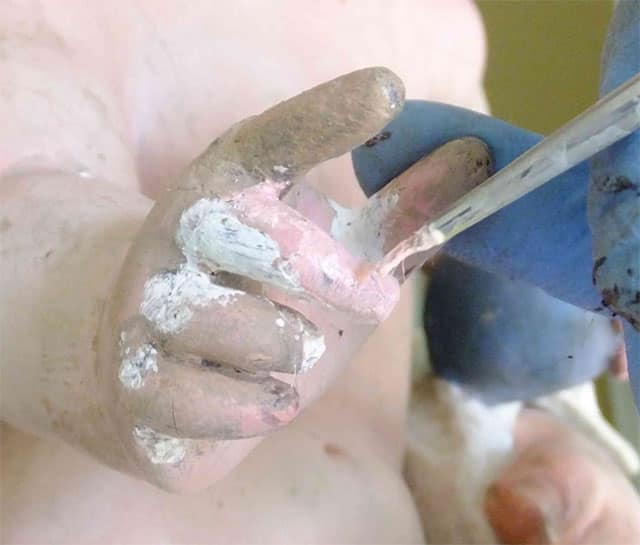First, I test some fluids (chemicals) to determine which to use, soak up some of the fluid in a cotton swab or similar, then carefully and slowly wipe the surface. The swab I use is a piece of cotton wool wrapped around a bamboo skewer. I do that because I can wrap the cotton wool myself, so I can use more if I want to wipe a larger area, or if I want to do a more detailed part, I can use a smaller amount. The part of the swab that comes in contact with the surface picks up the dirt and soon turns black, so I remove the cotton wool at the tip of the skewer then wind some clean cotton wool around the tip. It's then a matter of patiently carrying on with this procedure.

I sometimes find damage while I am removing the dirt from a sculpture, in which case I need to return it to its original condition before any further damage eventuates when I rub it with a cotton swab.

Sometimes a part has been lost, chipped or broken off. In cases like that, I might restore the part, depending on the owner's wishes, and attach it where it should be, but in most cases the part is not replaced, with the basic intention of preserving history.
A feature of this particular sculpture restoration job was the need for nail repair. I found a number of brown spots in various places on the finished surface. What's more, before applying the finish, the sculpted wood had been coated in something like plaster, and this layer had chipped here and there. You often see that in sculptures in bad condition, but in this case, the cause was rusted nails. They didn't have stainless steel nails in olden times, so there was nothing they could do about metal oxidation like this. Oxidized steel eventually makes plaster coatings and wood more fragile.
I search for any oxidized nails and remove any that are obviously unnecessary. I use a file to remove the rust from any metal fixings that hold the wood together, and from nails that I can't remove, then apply a rust preventative.


Once that is complete, the next job is to fill the holes and any part where the plaster has come away.

I make a paste of a creamy consistency by dissolving animal glue in the set amount of water, then mixing in some mineral powder. I fill the hole by applying it with a brush. First, I apply one layer, then let it dry, apply another layer, and so on, adding layers until it is slightly proud of the surrounding surface. Then I carefully sand it with a piece of sandpaper tapered to a point, to even it out.


Then finally comes the process of applying color with pigments over the mineral paste. I carefully apply the color so that it blends in with the surrounding surfaces, but it is essential to use materials which, on the day when the sculpture is repaired in another 10 or so years, will make the repaired part obvious and allow for easy removal of the pigment on the repaired part. It is also very important to use materials different to the those used in the original. The reason is that when it comes to the statue’s next cleaning, there is no sense in the chemical being used to remove the pigment applied at the last restoration to end up removing original coloring.


Then a thin coat of varnish is applied to the revived sculpture (although not in all cases), the ornaments attaching to the sculpture are nicely restored, and the whole process is complete.


































































